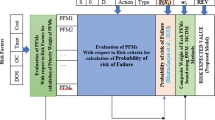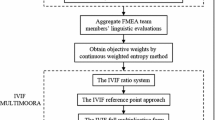Abstract
The equipment failure is an important factor that may cause accidents in the geothermal power plant. Failure mode and effect analysis (FMEA) has been widely adopted to prevent potential failures in various process enterprises. However, current FMEA models are inefficient to determine risk priority by considering the risk preference and reliability of expert within the context of interaction among risk factors. To overcome this shortcoming, this paper develops a hybrid risk prioritization method by integrating PROMETHEE-II method, Bonferroni mean operator and linguistic Z-number. Firstly, the linguistic Z-number is utilized to depict the reliability and uncertainty of experts. Then, the linguistic Z-number ordered weighted averaging operator is developed to aggregate the risk evaluation information from experts, which can reflect the actual performance of experts. In addition, the extended PROMETHEE-II method with distance-based weighting method and Bonferroni mean operator is proposed to calculate the risk priority, in which the interactions among risk factors and risk preference of expert are considered. Finally, the risk analysis of equipment failures in the geothermal power plant is selected to illustrate the proposed method. The comparison and sensitivity analyses are conducted to further validate its effectiveness.



Similar content being viewed by others
References
Wu, Y., Xu, C., Zhang, T.: Evaluation of renewable power sources using a fuzzy MCDM based on cumulative prospect theory: a case in China. Energy 147, 1227–1239 (2018)
Feili, H.R., Akar, N., Lotfizadeh, H., Bairampour, M., Nasiri, S.: Risk analysis of geothermal power plants using failure modes and effects analysis (FMEA) technique. Energy Convers. Manag. 72, 69–76 (2013)
Mohsen, O., Fereshteh, N.: An extended VIKOR method based on entropy measure for the failure modes risk assessment—a case study of the geothermal power plant (GPP). Saf. Sci. 92, 160–172 (2017)
Wang, Y., Yang, X., Yan, H.: Reliable fuzzy tracking control of near-space hypersonic vehicle using aperiodic measurement information. IEEE Trans. Ind. Electron. (2019). https://doi.org/10.1109/TIE.2019.2892696
Wang, Y., Shi, P., Yan, H.: Reliable control of fuzzy singularly perturbed systems and its application to electronic circuits. IEEE Trans. Circuits Syst. I Regul. Pap. 65(10), 3519–3528 (2018)
Ramírez-Camacho, J.G., Carbone, F., Pastor, E., Bubbico, R., Casal, J.: Assessing the consequences of pipeline accidents to support land-use planning. Saf. Sci. 97, 34–42 (2017)
Wang, W., Liu, X., Qin, Y., Fu, Y.: A risk evaluation and prioritization method for FMEA with prospect theory and Choquet integral. Saf. Sci. 110, 152–163 (2018)
Zhao, H., You, J.-X., Liu, H.-C.: Failure mode and effect analysis using MULTIMOORA method with continuous weighted entropy under interval-valued intuitionistic fuzzy environment. Soft. Comput. 21(18), 5355–5367 (2016)
Tian, Z-p, Wang, J-q, Zhang, H-y: An integrated approach for failure mode and effects analysis based on fuzzy best-worst, relative entropy, and VIKOR methods. Appl. Soft Comput. 72, 636–646 (2018)
Wang, W., Liu, X., Qin, J., Liu, S.: An extended generalized TODIM for risk evaluation and prioritization of failure modes considering risk indicators interaction. IISE Trans. (2018). https://doi.org/10.1080/24725854.2018.1539889
Nie, R-x, Tian, Z-p, Wang, X-k, Wang, J-q, Wang, T-l: Risk evaluation by FMEA of supercritical water gasification system using multi-granular linguistic distribution assessment. Knowl.-Based Syst. 162, 185–201 (2018)
Wang, Z., Gao, J.-M., Wang, R.-X., Chen, K., Gao, Z.-Y., Jiang, Y.: Failure mode and effects analysis using Dempster-Shafer theory and TOPSIS method: application to the gas insulated metal enclosed transmission line (GIL). Appl. Soft Comput. 70, 633–647 (2018)
Liu, H.-C., Chen, Y.-Z., You, J.-X., Li, H.: Risk evaluation in failure mode and effects analysis using fuzzy digraph and matrix approach. J. Intell. Manuf. 27(4), 805–816 (2016)
Sayyadi Tooranloo, H., Ayatollah, A.S.: A model for failure mode and effects analysis based on intuitionistic fuzzy approach. Appl. Soft Comput. 49, 238–247 (2016)
Yazdi, M., Daneshvar, S., Setareh, H.: An extension to Fuzzy developed failure mode and effects analysis (FDFMEA) application for aircraft landing system. Saf. Sci. 98, 113–123 (2017)
Bozdag, E., Asan, U., Soyer, A., Serdarasan, S.: Risk prioritization in failure mode and effects analysis using interval type-2 fuzzy sets. Expert Syst. Appl. 42(8), 4000–4015 (2015)
Zhou, Q., Thai, V.V.: Fuzzy and grey theories in failure mode and effect analysis for tanker equipment failure prediction. Saf. Sci. 83, 74–79 (2016)
Wang, Z.-L., You, J., Liu, H.-C., Wu, S.-M.: Failure mode and effect analysis using soft set theory and COPRAS method. Int. J. Comput. Intell. Syst. 10(1), 1002–1015 (2017)
Chin, K.-S., Wang, Y.-M., Ka Kwai Poon, G., Yang, J.-B.: Failure mode and effects analysis using a group-based evidential reasoning approach. Comput. Oper. Res. 36(6), 1768–1779 (2009)
Jiang, W., Xie, C., Zhuang, M., Tang, Y.: Failure mode and effects analysis based on a novel fuzzy evidential method. Appl. Soft Comput. 57, 672–683 (2017)
Liu, H.-C., You, J.-X., You, X.-Y., Shan, M.-M.: A novel approach for failure mode and effects analysis using combination weighting and fuzzy VIKOR method. Appl. Soft Comput. 28, 579–588 (2015)
Chang, K.-H., Cheng, C.-H.: A risk assessment methodology using intuitionistic fuzzy set in FMEA. Int. J. Syst. Sci. 41(12), 1457–1471 (2010)
Wang, L.-E., Liu, H.-C., Quan, M.-Y.: Evaluating the risk of failure modes with a hybrid MCDM model under interval-valued intuitionistic fuzzy environments. Comput. Ind. Eng. 102, 175–185 (2016)
Liu, H.-C., Liu, L., Liu, N., Mao, L.-X.: Risk evaluation in failure mode and effects analysis with extended VIKOR method under fuzzy environment. Expert Syst. Appl. 39(17), 12926–12934 (2012)
Liu, H.-C., You, J.-X., Fan, X.-J., Lin, Q.-L.: Failure mode and effects analysis using D numbers and grey relational projection method. Expert Syst. Appl. 41(10), 4670–4679 (2014)
Liu, H., Hu, Y., Wang, J., Sun, M.: Failure mode and effects analysis using two-dimensional uncertain linguistic variables and alternative queuing method. IEEE Trans. Reliab. (2018). https://doi.org/10.1109/TR.2018.2866029
Liu, H., Wang, L., Li, Z., Hu, Y.: Improving risk evaluation in FMEA with cloud model and hierarchical TOPSIS method. IEEE Trans. Fuzzy Syst. 27(1), 84–95 (2018)
Liu, H., Li, Z., Song, W., Su, Q.: Failure mode and effect analysis using cloud model theory and PROMETHEE method. IEEE Trans. Reliab. 66(4), 1058–1072 (2017)
Huang, J., You, X.-Y., Liu, H.-C., Si, S.-L.: New approach for quality function deployment based on proportional hesitant fuzzy linguistic term sets and prospect theory. Int. J. Prod. Res. (2018). https://doi.org/10.1080/00207543.2018.1470343
Liu, X., Tao, Z., Chen, H., Zhou, L.: A new interval-valued 2-tuple linguistic Bonferroni mean operator and its application to multiattribute group decision making. Int. J. Fuzzy Syst. 19(1), 86–108 (2017)
Huang, J., Li, Z., Liu, H.-C.: New approach for failure mode and effect analysis using linguistic distribution assessments and TODIM method. Reliab. Eng. Syst. Saf. 167, 302–309 (2017)
Kerk, Y.W., Tay, K.M., Lim, C.P.: An analytical interval fuzzy inference system for risk evaluation and prioritization in failure mode and effect analysis. IEEE Syst. J. 11(3), 1589–1600 (2017)
Liu, H., You, J., Li, P., Su, Q.: Failure mode and effect analysis under uncertainty: an integrated multiple criteria decision making approach. IEEE Trans. Reliab. 65(3), 1380–1392 (2016)
Kuang, H., Kilgour, D.M., Hipel, K.W.: Grey-based PROMETHEE II with application to evaluation of source water protection strategies. Inf. Sci. 294, 376–389 (2015)
Strantzali, E., Aravossis, K., Livanos, G.A.: Evaluation of future sustainable electricity generation alternatives: the case of a Greek island. Renew. Sustain. Energy Rev. 76, 775–787 (2017)
Peng, H-g, Shen, K-w, He, S-s, Zhang, H-y, Wang, J-q: Investment risk evaluation for new energy resources: an integrated decision support model based on regret theory and ELECTRE III. Energy Convers. Manag. 183, 332–348 (2019)
Zadeh, L.A.: A note on Z-numbers. Inf. Sci. 181(14), 2923–2932 (2011)
Wang, J-q, Cao, Y-x, Zhang, H-y: Multi-criteria decision-making method based on distance measure and Choquet integral for linguistic Z-numbers. Cognit. Comput. 9(6), 827–842 (2017)
Bonferroni, C.: Sulle medie multiple di potenze. Boll. Mat. Ital. 5(3–4), 267–270 (1950)
Zhu, B., Xu, Z., Xia, M.: Hesitant fuzzy geometric Bonferroni means. Inf. Sci. 205, 72–85 (2012)
Brans, J.P., Vincke, P., Mareschal, B.: How to select and how to rank projects: the Promethee method. Eur. J. Oper. Res. 24(2), 228–238 (1986)
Govindan, K., Kadziński, M., Sivakumar, R.: Application of a novel PROMETHEE-based method for construction of a group compromise ranking to prioritization of green suppliers in food supply chain. Omega 71, 129–145 (2017)
de Almeida Filho, A.T., Clemente, T.R.N., Morais, D.C., de Almeida, A.T.: Preference modeling experiments with surrogate weighting procedures for the PROMETHEE method. Eur. J. Oper. Res. 264(2), 453–461 (2018)
Krishankumar, R., Ravichandran, K.S., Saeid, A.B.: A new extension to PROMETHEE under intuitionistic fuzzy environment for solving supplier selection problem with linguistic preferences. Appl. Soft Comput. 60, 564–576 (2017)
Qin, Q., Liang, F., Li, L., Chen, Y.-W., Yu, G.-F.: A TODIM-based multi-criteria group decision making with triangular intuitionistic fuzzy numbers. Appl. Soft Comput. 55, 93–107 (2017)
Reimann, O., Schumacher, C., Vetschera, R.: How well does the OWA operator represent real preferences? Eur. J. Oper. Res. 258(3), 993–1003 (2017)
Andreopoulou, Z., Koliouska, C., Galariotis, E., Zopounidis, C.: Renewable energy sources: using PROMETHEE II for ranking websites to support market opportunities. Technol. Forecast. Soc. Change 131, 31–37 (2018)
Tian, Z-p, Wang, J., Wang, J-q, Zhang, H-y: An improved MULTIMOORA approach for multi-criteria decision-making based on interdependent inputs of simplified neutrosophic linguistic information. Neural Comput. Appl. 28(1), 585–597 (2017)
Corrente, S., Figueira, J.R., Greco, S.: The SMAA-PROMETHEE method. Eur. J. Oper. Res. 239(2), 514–522 (2014)
Peng, H-g, Wang, J-q: Hesitant uncertain linguistic Z-numbers and their application in multi-criteria group decision-making problems. Int. J. Fuzzy Syst. 19(5), 1300–1316 (2017)
Wang, W., Liu, X., Qin, J.: Risk priorization for failure modes with extended MULTIMOORA method under interval type-2 fuzzy environment. J. Intell. Fuzzy Syst. 36(2), 1417–1429 (2019)
Acknowledgements
This work was supported by the MOE Ministry of Education in China (MOE), Project of Humanities and Social Sciences (19YJC630160).
Author information
Authors and Affiliations
Corresponding author
Appendices
Appendix A
Proof
The mathematical induction on \(k\) is adopted to prove Theorem 1 expressed by Eq. (16); the proving process is presented as follows:
-
(1)
When \(k = 1\), \(\omega^{(1)} = 1\), it is right obviously.
-
(2)
Assume that Eq. (16) holds for \(k = q\), i.e.,
$${\text{LZ-OWA}}_{\omega } \left( {a_{1} ,a_{2} , \ldots ,a_{q} } \right) = \sum\limits_{{i^{\prime} = 1}}^{q} {\left( {f^{ * - 1} \left( {\omega^{{i^{\prime}}} f^{ * } \left( {A_{{\phi \sigma (i^{\prime})}} } \right)} \right),B_{{\varphi \sigma (i^{\prime})}} } \right)}$$Then, when \(k = q + 1\), by the algorithms of linguistic Z-numbers in Definition 2, we have
$$\begin{aligned} & {\text{LZ-OWA}}_{\omega } \left( {a_{1} ,a_{2} , \ldots ,a_{q + 1} } \right) \\ & \quad = \omega^{(1)} a_{\sigma (1)} \oplus \omega^{(2)} a_{\sigma (2)} \oplus \cdots \oplus \omega^{(q + 1)} a_{\sigma (q + 1)} \\ & \quad = \left( {f^{ * - 1} \left( {\omega^{(1)} f^{ * } \left( {A_{{\phi \left( {\sigma (1)} \right)}} } \right)} \right),B_{{\varphi \left( {\sigma (1)} \right)}} } \right) \oplus \left( {f^{ * - 1} \left( {\omega^{(2)} f^{ * } \left( {A_{{\phi \left( {\sigma (2)} \right)}} } \right)} \right),B_{{\varphi \left( {\sigma (2)} \right)}} } \right) \\ & \quad \quad \oplus \cdots \oplus \left( {f^{ * - 1} \left( {\omega^{(q + 1)} f^{ * } \left( {A_{{\phi \left( {\sigma (q + 1)} \right)}} } \right)} \right),B_{{\varphi \left( {\sigma (q + 1)} \right)}} } \right) \\ & \quad = \sum\limits_{{i^{\prime} = 1}}^{q + 1} {\left( {f^{ * - 1} \left( {\omega^{{(i^{\prime})}} f^{ * } \left( {A_{{\phi \left( {\sigma (i^{\prime})} \right)}} } \right)} \right),B_{{\varphi \left( {\sigma (i^{\prime})} \right)}} } \right)} \\ \end{aligned}$$So, when \(k = q + 1\), Eq. (16) is also right.
Consequently, according to mathematical induction presented in (1) and (2), Eq. (14) holds for all \(k\).\(\square\)
Appendix B
Proof
-
(1)
As \(a_{{i^{\prime}}} = a_{0} = \left( {A_{\phi (0)} ,B_{\varphi (0)} } \right)\left( {i^{\prime} = 1, \ldots k, \ldots ,q} \right)\), and \(\sum\limits_{{i^{\prime} = 1}}^{q} {\omega^{{(i^{\prime})}} } = 1\), by the algorithms of linguistic Z-numbers in Definition 2, we have
$$\begin{aligned} & {\text{LZ-OWA}}_{\omega } \left( {a_{1} , \ldots, a_{k} , \ldots ,a_{q} } \right) \\ & \quad = {\text{LZ-OWA}}_{\omega } \left( {a_{0} , \ldots, a_{0} , \ldots ,a_{q} } \right) \\ & \quad = \sum\limits_{{i^{\prime} = 1}}^{q} {\left( {f^{ * - 1} \left( {\omega^{{(i^{\prime})}} f^{ * } \left( {A_{\phi (0)} } \right)} \right),B_{\varphi (0)} } \right)} \\ & \quad = \left( {f^{ * - 1} \left( {\sum\nolimits_{{i^{\prime} = 1}}^{q} {\omega^{{(i^{\prime})}} } \times f^{ * } \left( {A_{\phi (0)} } \right)} \right),g^{ * - 1} \left( {\frac{{\left( {\sum {f^{ * } \left( {A_{\phi (0)} } \right)} } \right) \times g^{ * } \left( {B_{\varphi (0)} } \right)}}{{\sum {f^{ * } \left( {A_{\phi (0)} } \right)} }}} \right)} \right) \\ & \quad = \left( {f^{ * - 1} \left( {\sum\nolimits_{{i^{\prime} = 1}}^{q} {\omega^{{(i^{\prime})}} } \times f^{ * } \left( {A_{\phi (0)} } \right)} \right),g^{ * - 1} \left( {g^{ * } \left( {B_{\varphi (0)} } \right)} \right)} \right) \\ \end{aligned}$$Since \(\sum\limits_{{i^{\prime} = 1}}^{q} {\omega^{{(i^{\prime})}} } = 1\), then we can obtain
$$\begin{aligned} & \left( {f^{ * - 1} \left( {\sum\nolimits_{{i^{\prime} = 1}}^{q} {\omega^{{(i^{\prime})}} } \times f^{ * } \left( {A_{\phi (0)} } \right)} \right),g^{ * - 1} \left( {g^{ * } \left( {B_{\varphi (0)} } \right)} \right)} \right) \\ & \quad = \left( {f^{ * - 1} \left( {f^{ * } \left( {A_{\phi (0)} } \right)} \right),g^{ * - 1} \left( {g^{ * } \left( {B_{\varphi (0)} } \right)} \right)} \right) \\ & \quad = \left( {A_{\phi (0)} ,B_{\varphi (0)} } \right) = a_{0} \\ \end{aligned}$$\(\square\)
-
(2)
Assume that \(a_{\hbox{min} } = c = \left( {A_{\phi (c)} ,B_{\varphi (c)} } \right)\), \(a_{\hbox{max} } = d = \left( {A_{\phi (d)} ,B_{\varphi (d)} } \right)\), then
$$\begin{aligned} & {\text{LZ-OWA}}_{\omega } \left( {a_{1} , \ldots, a_{k} , \ldots ,a_{q} } \right) \\ & \quad = \sum\limits_{{i^{\prime} = 1}}^{q} {\left( {f^{ * - 1} \left( {\omega^{{(i^{\prime})}} f^{ * } \left( {A_{{\phi (i^{\prime})}} } \right)} \right),B_{{\varphi (i^{\prime})}} } \right)} \\ & \quad \ge \sum\limits_{{i^{\prime} = 1}}^{q} {\left( {f^{ * - 1} \left( {\omega^{{(i^{\prime})}} f^{ * } \left( {A_{\phi (c)} } \right)} \right),B_{\varphi (c)} } \right)} = \left( {A_{\phi (c)} ,B_{\varphi (c)} } \right) \\ \end{aligned}$$and
$$\begin{aligned} & {\text{LZ-OWA}}_{\omega } \left( {a_{1} , \ldots, a_{k} , \ldots ,a_{q} } \right) \\ & \quad = \sum\limits_{{i^{\prime} = 1}}^{q} {\left( {f^{ * - 1} \left( {\omega^{{(i^{\prime})}} f^{ * } \left( {A_{{\phi (i^{\prime})}} } \right)} \right),B_{{\varphi (i^{\prime})}} } \right)} \\ & \quad \le \sum\limits_{{i^{\prime} = 1}}^{q} {\left( {f^{ * - 1} \left( {\omega^{{(i^{\prime})}} f^{ * } \left( {A_{\phi (d)} } \right)} \right),B_{\varphi (d)} } \right)} = \left( {A_{\phi (d)} ,B_{\varphi (d)} } \right) \\ \end{aligned}$$Therefore, we can get
$$a_{\hbox{min} } \le {\text{LZ-OWA}}_{\omega } \left( {a_{1} , \ldots, a_{k} , \ldots ,a_{q} } \right) \le a_{\hbox{max} }$$\(\square\)
-
(3)
Let \({\text{LZ-OWA}}_{\omega } \left( {a_{1} , \ldots, a_{k} , \ldots ,a_{q} } \right) = \sum\limits_{{i^{\prime} = 1}}^{q} {\left( {f^{ * - 1} \left( {\omega^{{(i^{\prime})}} f^{ * } \left( {A_{{\phi (\sigma (i^{\prime}))}} } \right)} \right),B_{{\varphi (\sigma (i^{\prime}))}} } \right)}\), \({\text{LZ-OWA}}_{\omega } \left( {b_{1} , \ldots b_{k} , \ldots ,b_{q} } \right) = \sum\limits_{{j^{\prime} = 1}}^{q} {\left( {f^{ * - 1} \left( {\omega^{{(j^{\prime})}} f^{ * } \left( {A_{{\phi (\sigma (j^{\prime}))}} } \right)} \right),B_{{\varphi (\sigma (j^{\prime}))}} } \right)} .\) Since \(A_{{\phi (i^{\prime})}} \le A_{{\phi (j^{\prime})}}\), \(B_{{\varphi (i^{\prime})}} \le B_{{\varphi (j^{\prime})}}\), it follows that \(a_{{\sigma (i^{\prime})}} \le b_{{\sigma (j^{\prime})}} \left( {i^{\prime},j^{\prime} = 1,2, \ldots ,q} \right)\), then
$${\text{LZ-OWA}}_{\omega } \left( {a_{1} , \ldots, a_{k} , \ldots ,a_{q} } \right) \le {\text{LZ-OWA}}_{\omega } \left( {b_{1} , \ldots b_{k} , \ldots ,b_{q} } \right) .$$\(\square\)
Rights and permissions
About this article
Cite this article
Zhang, Hj., Zhou, Y. & Gan, Qh. An Extended PROMETHEE-II-Based Risk Prioritization Method for Equipment Failures in the Geothermal Power Plant. Int. J. Fuzzy Syst. 21, 2490–2509 (2019). https://doi.org/10.1007/s40815-019-00679-x
Received:
Revised:
Accepted:
Published:
Issue Date:
DOI: https://doi.org/10.1007/s40815-019-00679-x




